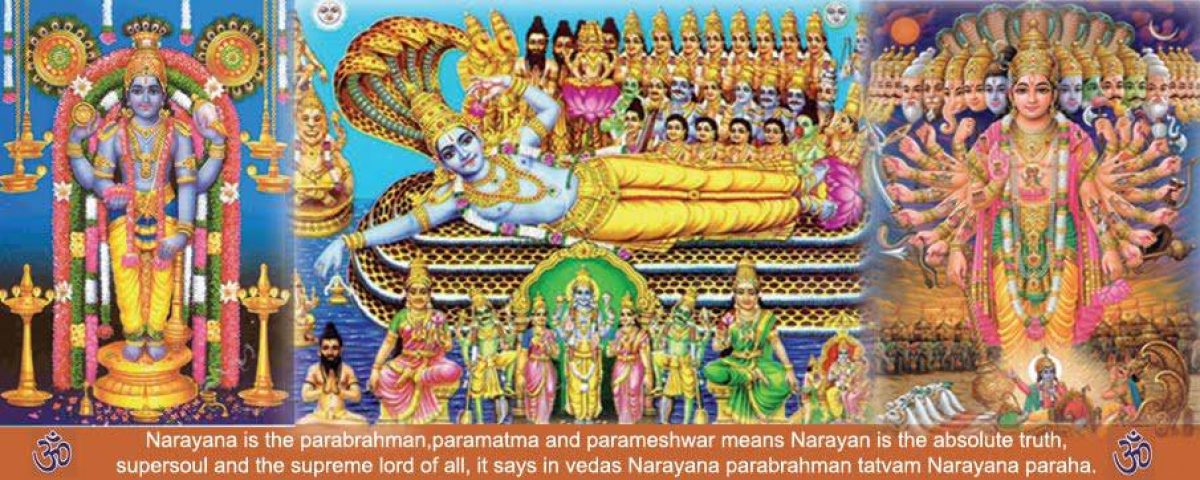Author Dr. Mathangi Subramanian, an educator and alumnus of Brown and Columbia Universities, who authored a book on marginalized women, tweeted outrage regarding a new Netflix television sitcom about Indian-Americans. Why the outrage? Evidently, because the Indian-Americans in question are Brāhmins:
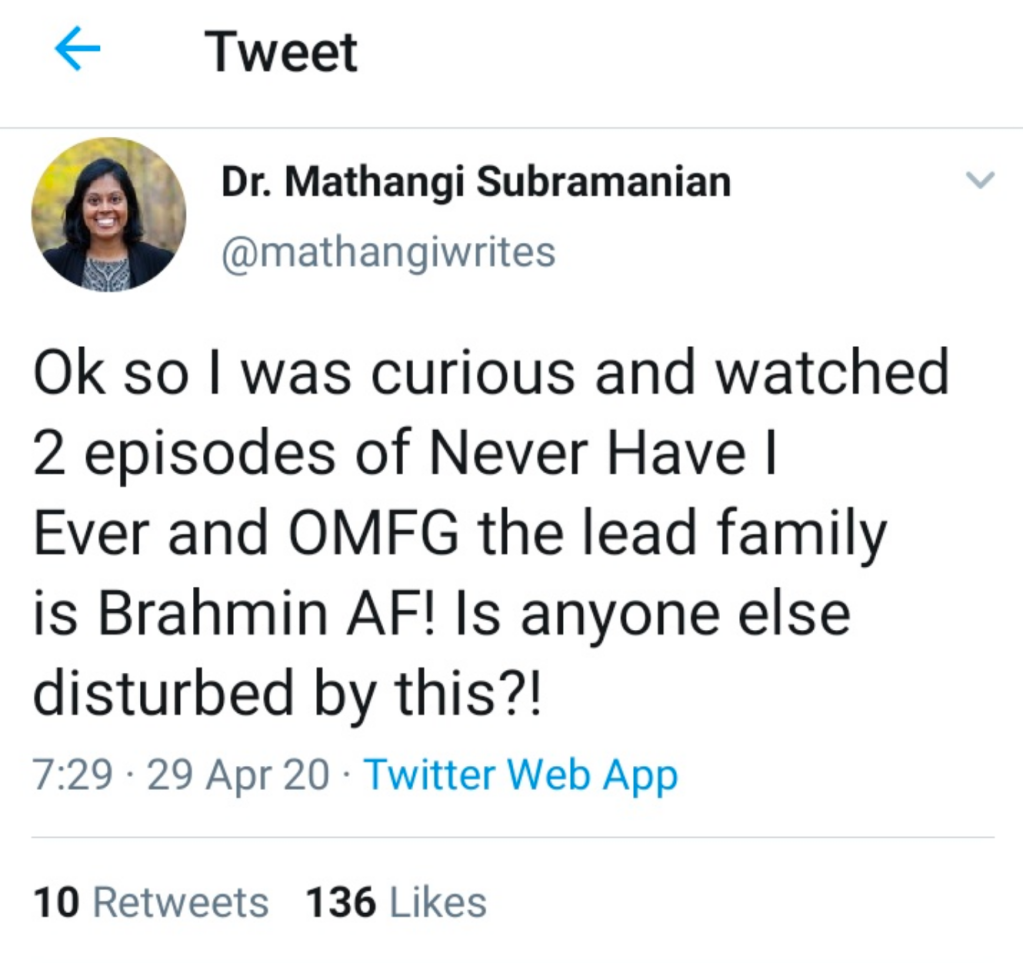
They were Brāhmins, she asserts, because the women wore mangala-sutras, were vegetarian, and had religious icons in their home shrines:
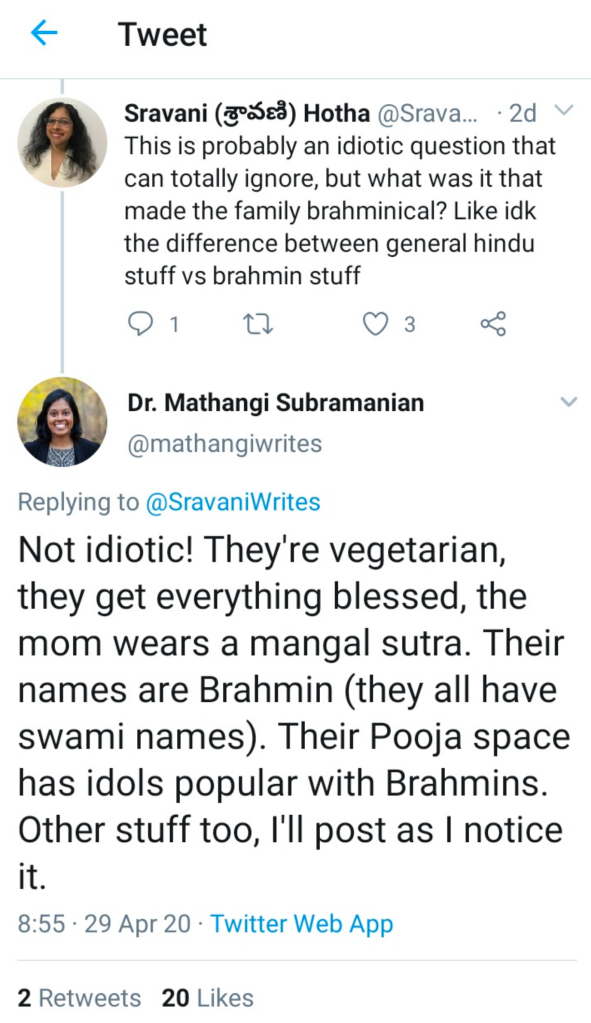
In fact, none of these customs are specific to Brāhmins. Many non-Brāhmin married women wear mangala-sutras. Many non-Brāhmin Hindus are vegetarian and worship deities like Veṅkaṭeśvara, Lakṣmī, Kṛṣṇa, Rāma, Śiva, Durgā, and Gaṇeśa. Are we to believe that an Ivy-League-educated, Indian-origin, educator is completely oblivious to these facts, or could it be that the “Brāhmin” issue is merely her pretext for objecting to visibly Hindu characters being portrayed in mainstream media? Whatever the case, at least one non-Indian, non-Brahmin Hindu perceived the crassness of her complaints and protested:

Indeed. Calling into question someone’s cultural identity as the sole basis for objecting to them is prototypical bigotry. But Subramanian informed us that bigotry is ok in this case, because she is a Brāhmin, too:
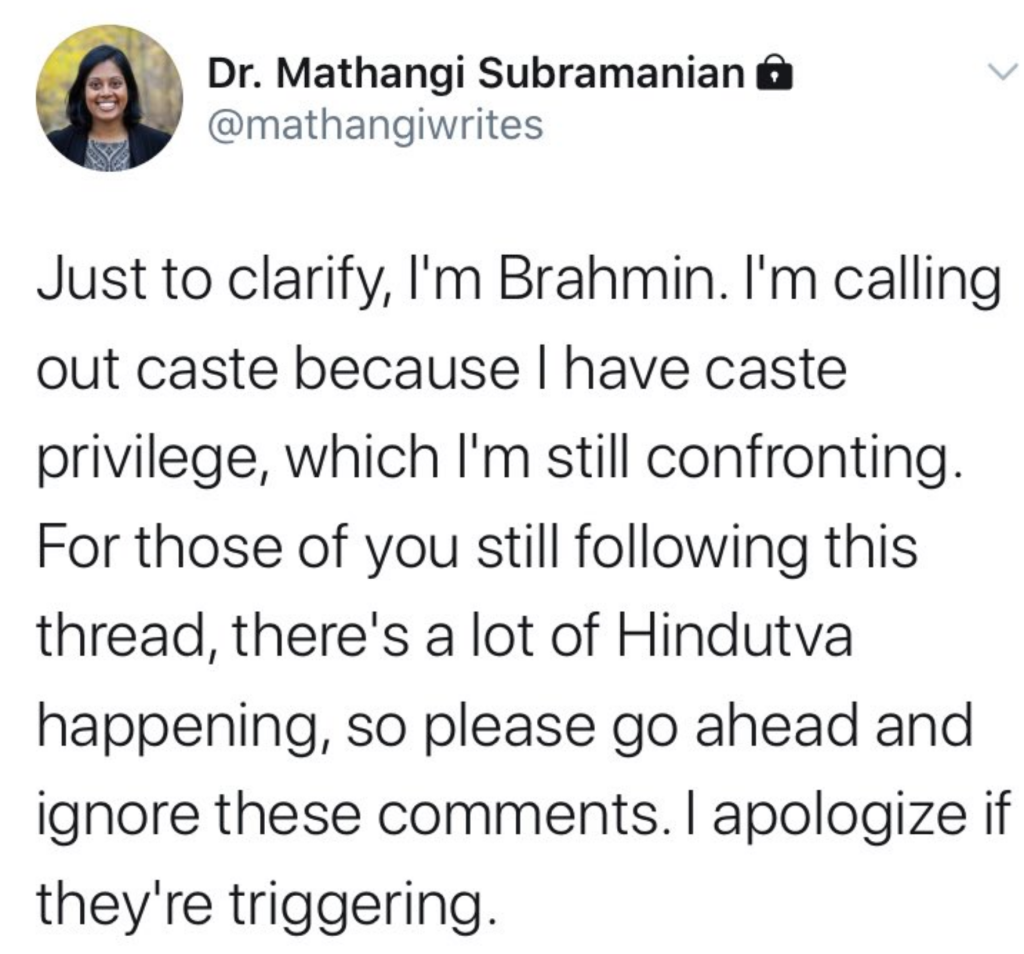
So in other words, as a “Brāhmin,” she has the moral right to insist that Brāhmins not be represented in the popular media unless they are first depicted as spoiled and privileged. By Subramanian’s logic, she should agree that an African-American has a right to use racially-charged remarks about other African-Americans. Though we doubt that she would.
We have written before about the myth of Brāhmin “caste privilege” here, showing how it is little more than a repackaged version of Anti-Semitism for 21st century India. That Subramanian feels her Brāhmin status gives her a right to peddle in Anti-Brāhmin hate, ignores her obvious secondary gain from the use of dehumanizing stereotypes to curry favor with polarized, left-wing ideologues. From her comfortable perch in the big city, insulated from the grinding reality of rural Indians who lack her Ivy-League privilege, Subramanian can engage in virtue-signaling by lecturing Brāhmins on their alleged “privilege,” while ignoring the fact that Brāhmins are a minority in India of whom over 50% live in poverty. Subramanian should reflect on the irony that despite profiting off of a book about marginalized women, she is thumbing her nose at people who lack her socioeconomic privilege, all the while engaging in the regressive tactic of collectivist-group think and class-shaming.
The Hindu Post exposed the activities of “Harvest India,” a Christian organization devoted to seeking converts from India. Its President Suresh Kumar Kathera says of his work that, “1.3 billion Indians worship 330 million gods, but they need to see who is, who has the power, who is Jesus…. There is a place called Kodooru, Andhra Pradesh, India, we’ve been praying for that place for many years to go and to have crusade. That is one of the stronghold of enemy and people do witchcraft and black magic…. that is one of the biggest places for idol worship.”
As if this peddling of anti-Hindu hatred were not enough, Kathera (not suprisingly) sings the typical song about Christian persecution in India. The article notes that, “He alleges that ‘many pastors were killed’ in Bharat without providing any evidence for the same. Nowhere are churches ‘burning’ in Bharat except in Mr. Kathera’s wild imagination.” In other words, to deflect from his own hateful comments, he played the victim card by manufacturing claims about anti-Christian hatred.
The basic premise underlying Christianity’s anti-Hindu xenophobia is the narrative of the “330 million gods” myth about Hinduism, which appears to be a distortion of the Bṛhadāraṇyaka Upaniṣad 3.9.1-10 in which Yājñavalkya is asked to enumerate the actual number of devas. In the Vedic worldview, the devas are celestial beings who administer over some aspect of the universe, powerful and long-lived, but still mortal, fallible, and dependent on the Supreme Deity known in Vedānta as Brahman. To emphasize this point, Yājñavalkya answers with progressively lower numbers beginning with “303 and 3003,” then “33,” then “6,” then “3,” then “2,” then “1 1/2,” and finally “1.” Of that one Deva, the Upaniṣad 3.9.19-20 says, “Which is the one God? The vital force (Hiranyagarbha); it is Brahman, which is called ‘Tyat’ (that). He who knows that Being Whose abode is the Earth, Whose instrument of vision is Fire, Whose light is the Manas, and Who is the ultimate resort of the entire body and organs, knows truly.” In other words, the One Deva is Brahman, the ultimate resort of all, Whose powers are represented by the other devas. Most people can readily appreciate that this is a monotheistic statement, quite contrary to the “330 million gods” myth.
It is a fact that Hindus collectively worship many different deities, but that does not make Hinduism a polytheistic religion. How can this be? Let us consider a hypothetical situation in which a technologically superior culture invaded the Middle East around 8th century C.E. To them, the Jews, Christians, and Muslims would seem to be different members of a single religion which the invaders will dub “Jordanism,” because their city-states originated around the Jordan River area. They note that some of the Jordanists worship Elohim, others worship Jehovah, and still others worship Allah. They then conclude that Jordanism is a polytheistic religion.
The point of this analogy is to illustrate the fact that, in contrast to our usage, “Hinduism” is used by foreigners as a term of convenience to describe anyone following traditions originating in India, regardless of how Vedic or non-Vedic those beliefs and practices might be. Just as Judaism, Christianity, and Islam are separate religious traditions with some common history and development of beliefs, so also are Vaiṣṇavism, Śaivism, Śāktaism, Smārthaism, etc different religious traditions which are only conveniently characterized as one to accommodate the laziness of foreign observers. This is pluralism, not polytheism, and its existence is a testimony to the highly tolerant social ethos of Hindu civilization, which is not compatible with the religious pogroms, inquisitions, or persecution of heretics seen in the histories of other world religions.
In our last article on Hinduphobia, we noted how bigoted, opportunistic, Christian preachers construct the Christian persecution narrative in order to deflect from the ramifications of their conversion activities. The destruction of the centuries-old, Hindu culture, the breaking apart of Indian families over religion, the fraudulent methods used to entice uneducated villagers to convert, and the Christianity-inspired violence against Hindu spiritual leaders are all downplayed or ignored by Christian proselytizers solely to throw attention away from their deceitful and xenophobic behavior.
Many people take their freedoms for granted, but this is dangerous to do for Hindus in some parts of India. The Voice of the Nation Organiser carried this story about a Hindu woman who was threatened for turning on a television during her Muslim neighbor’s observance of Ramadan.
That day too she was listening to the news when her neighbor Samiruddin, started abusing her in the vilest of language. The reason, she should not watch TV at that time as it was disturbing their namaz in the holy month of Ramzan. When she came out of the house, another neighbour, Mobidul Rahman also came with a dao (a kind of large knife) in hand and he too started abusing her. In a fit of uncontrollable anger, he even hit the ground with his dao near her feet. Samiruddin then grabbed her neck, and slapped her in the face several times because she watching TV was disturbing their namaz.
https://www.organiser.org/Encyc/2020/5/4/Hindu-woman-assaulted-by-Muslim-neighbours-in-Assam-and-threatened-to-have-throats.html
Her neighbors also objected to her marrying a Muslim man who converted to Hinduism for her sake, and further objected to her setting up a small family temple – in their own home.
Jahnabi Gogoi informed us that this is not the first time her Muslim neighbours quarreled with her. According to her, their main grudge is she persuaded her Muslim husband Md. Kapil Uddin to leave his family religion Islam and become a Hindu. In an affidavit signed on 19-7-2017 before the notary public at Sivasagar, her husband declared that he converted himself from Islam to Hindu by his own will and free consent and would be known as Kapil Gogoi instead of his former name Kapil Uddin. Previously, her Muslim neighbors also objected to her establishing a small temple in her house for her family’s private worship. The assailants and their protectors have now resorted to arm-twisting and started threatening the witnesses.
https://www.organiser.org/Encyc/2020/5/4/Hindu-woman-assaulted-by-Muslim-neighbours-in-Assam-and-threatened-to-have-throats.html
It is difficult to understand how anyone can rationalize objecting to what a person does in the privacy of his or her own home, but hatred of Hinduism enables this behavior among Islamic conservatives. And they are not the only ones.
Do the devotees of a Hindu temple have the right to erect statues on the property of Hindu temples in India, one of the few Hindu-majority countries in the world? Not really. Multiple news sources reported on a bizarre story in which a “Bharat-Mata” statue on the premises of a 200-year-old Durgā temple in Tamil Nadu was covered up by police because it offended the sentiments of local Christians.
According to local media reports, the Bharat Mata statue was inside a 200-year-old Isakki Amman (Durga) temple in Puliyur village. Recently, a family of a daily worker Muthu Kumar had erected the Bharat Mata statue and adorned.
https://swarajyamag.com/insta/tamil-nadu-police-cover-bharat-mata-statue-in-kanyakumari-as-locals-in-vicinity-complain-their-sentiments-are-hurt
However, Christians of the Church of South India (CSI) living in the vicinity complained that the statue affected their “religious sentiments”. This led to the district superintendent of police asking his personnel to cover the statue. The local sub-inspector of police asked the locals to remove the statue or face action.
As one can see from the picture of the uncovered statue further on in the story, there is nothing particularly offensive about it. “Bharat-Mata” (Mother India) is not even a Vedic deity, though the devotees might conceptualize her as a form of Durgā. Similar sculptures of gods and goddesses can be found at Hindu temples all over India, except that most of these are not located in areas where Christians are just as populous as Hindus, constituting 46.85% of the local population as compared to 48.65%, respectively. No doubt, the Christians looked at the statue as a dreaded “idol” and decided to flex their political muscle to show the heathen Hindus who is boss. The Tamil Nadu police was ever so happy to appease the Christian prejudice since they are a minority and secular wisdom in India holds that minorities are always victims until proven otherwise.
In the complaint the President of AICDA (All-India Christian Development Army), Theodore Sam, has mooted that the statue has come up during the period of the lockdown suddenly with an ulterior motive to disrupt communal harmony.
https://goachronicle.com/christian-group-files-complaint-against-bharat-mata-statue/
The AICDA has petitioned the District Collector to remove the Bharat Mata statue because it could lead to future communal strife in the area.
It is difficult to understand how a statue of “Mother India” on the private premises of a Hindu temple could possibly be construed as an attempt to “disrupt communal harmony.” This appears to be a code phrase for Christians who want use the machinery of the State to silence expressions of Hindu faith and/or national pride. The implications of this incident on freedom of religion and speech are chilling, and once again show that Hindus are treated as an unwanted minority even in their own ancestral homeland.
But at least no one died in the Puliyur Village statue controversy. The same cannot be said of yet another couple of sādhus from Maharashtra. On the heels of the brutal lynching of two sadhus in Palghar, Op India reported on the deaths of two more sadhus murdered in their own ashram:
According to the reports, the bodies of the Sadhus were found in their ashram in Maharashtra’s Nanded late on Saturday night. The deceased sadhus have been identified as Balbrahmachari Shivacharya Maharaj guru, and Bhagwan Shinde, a disciple of Sadhu Shivacharya Maharaj.
https://www.opindia.com/2020/05/maharashtra-nanded-ashram-sadhu-murdered-robbery/
According to Maharashtra police, the accused had entered the mutt with an intention to steal. However, when objected, the accused strangled the seer and his accomplice to death with a charging cable.
Following the double murder, tension has gripped in the surrounding areas of the district. Reportedly, the seer was a well-known mahant of the district and had involved in the development work of the area for a long time.
Hindu culture is incredibly diverse, but all Hindus understand instinctively the respect that must be paid to sadhus, who are by nature non-violent and compassionate. Whether this violence was carried out solely for monetary gain, or there was a hidden sectarian agenda involved is not known at this time. What is clear is that the assailants had no qualms about murdering Hindu holy men, just like the mob involved in the Palghar lynching, who are now believed to have been the victims of premeditated murder motivated by sectarian interests.
Math may be the universal language, but in Muslim-majority Bangladesh, it is a tool for indoctrinating young children into Islamic jihadi ideology, as this grade-school math textbook posted on social media shows:
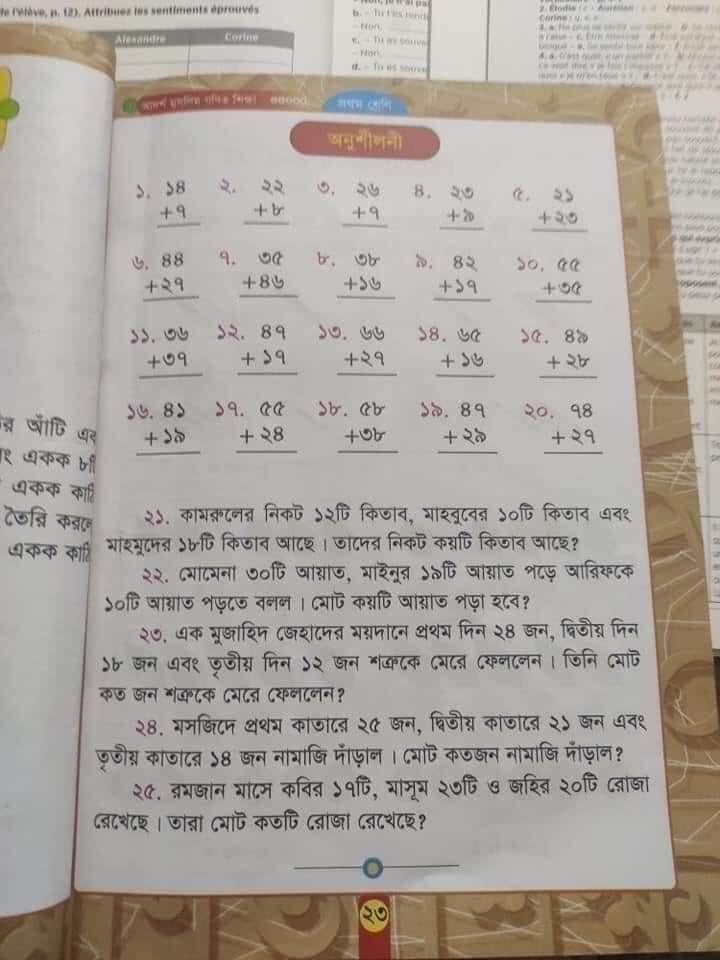
The text reads, “If a Jihadi killed 24 kafirs on the first day, 18 on the second day, and 12 on the third day, then how many total did he kill?” The People’s Republic of Bangladesh is the fourth largest Muslim-majority country in the world. Although officially a secular country, it has a dark, ongoing history of ethnic cleansing of its Hindu minority, who constituted 22% of its population in 1951 and now are less than 9%.
One would think that a major multinational company that employs people of all religious, cultural, and ethnic backgrounds would have policies in place against discrimination. If so, they evidently did not apply to this Spacecraft Chief Engineer and Senior Scientist at Boeing Satellite Systems in California, who openly referred to Congresswoman Tulsi Gabbard as a “Hindu b*tch” who “must be sent to hell.”
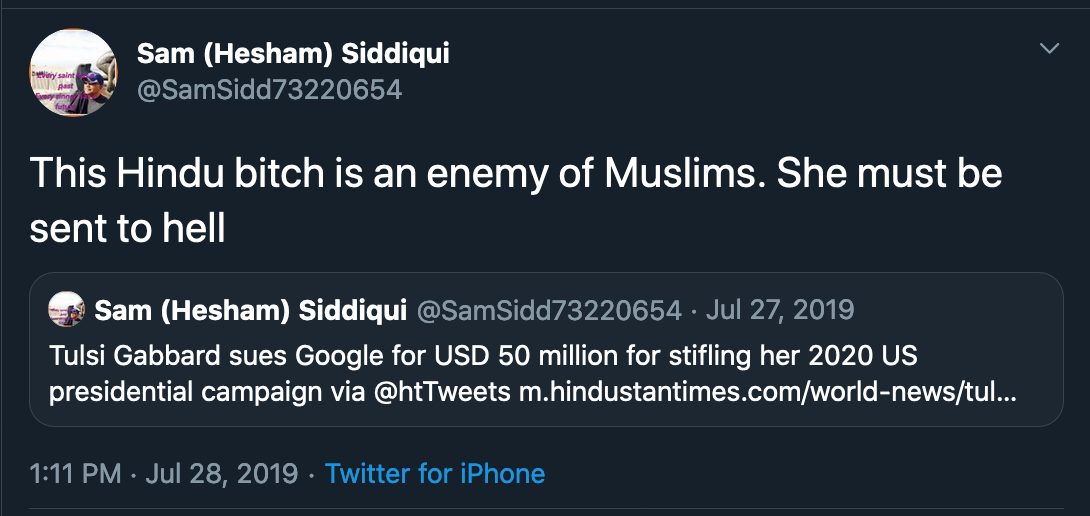

The tweet is actually from 2019 but only recently surfaced in a routine review of our social media feed. It is chilling that such a brazenly, bigoted individual could find employment in a major aerospace engineering firm, and attain the rank of a senior scientist and chief engineer. The only silver lining of this dark cloud is that Boeing evidently fired him, the reasons given not being specified, but probably do not require much imagination to deduce.
Prejudice against Hindus and Hinduism is real and continues to have the potential to cause discriminatory policing, biased government policies, and violent consequences. Whether it is coming from Christianity, Islam, leaders in industry, or the halls of leftist academia, it should be a concern to anyone interested in fairness and justice that Hinduphobia has disturbingly become socially acceptable in mainstream society.
